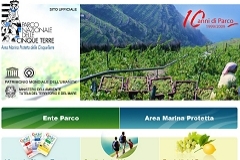Natural parks management is undoubtedly an extremely complicated and difficult task. Park ecosystems are complex and vary tremendously over time and space. Parks authorities must be capable of determining whether the changes they observe in park resources are the result of natural variability or the effects of anthropogenic activities.
The Earth Observation and the derived products can greatly improve the land management providing high resolution data in support to the territory safeguard and environmental monitoring.
Among the applications based on the Earth Observation funded by ESA EOMD program, PARC service offers a powerful solution for the natural resources conservation using hyperspectral and very high resolution data with the new web mapping technology.

Park service is the result of a project ended some years ago.
The set of cartographic products derived from the EO data processing were based on images acquired from hyperspectral CHRIS PROBA and very high resolution satellite data, such IKONOS satellites (at the time the system was developed). CHRIS PROBA data were processed in order to derive the following experimental products: vegetation index map, multiangle and multiband compositions in supporting the land cover analysis.
The IKONOS image were geo-rectified and processed in order to obtain a land use map.
The EO services provided by PARC system can be grouped in the following categories:
- EO Imagery geo-rectification of very high resolution satellite imagery (i.e. IKONOS);
- Land-cover map service derived by very high resolution data (i.e. IKONOS);
- Vegetation index and experimental land features extraction from hyperspectral CHRIS PROBA satellite data.

All the geographical information provided by the EO-based services (e.g. Ikonos image, land-cover map) have been integrated into a WebGIS system based on MapServer technology. This allows the park staff to integrate, explore and publish any kind of data having geographical references.
The innovative aspect of PARC service, which can help the promotion of natural park resources, consists in the integration of a WebGIS interface with Google Earth application, currently the most used cartographic tool at global scale available in the internet.
The consultation of the park cartography by Google Earth application allows a totally dynamic interaction and does not need any pre-processing of data. The WebGIS interface of PARC service enables the users to start the 3D map visualization at any time during the 2D map consultation using all the functionalities available with Google Earth.
Another effective promotional instrument available with PARC service consists in the direct interaction between the system and the park visitors. In fact, the webGIS interface can be used to indicate sites which can have a particular interest to the community and put placemarks of the most attractive places in the park, food and lodging structures, flora and fauna remarks, adding pictures and comments on the map. In this way, after the administrator check, the geographical layer realized using the input of the community can be available by PARC service both in webGIS and Google Earth mode (see Figure 1).
The service was developed for Cinque Terre National Park in Liguria, Italy, UNESCO cultural landscape since December 1997.
PARC service is able to facilitate the following procedures:
- Earth Observation data collection for situation monitoring and analysis;
- Publication of the cartographic information on Internet;
- Cartographic 2D and 3D consultation exploiting integration with Google Earth environment;
- Direct interaction between users and PARC system by inserting and updating tourist/naturalistic information about the park.
The service activities performed by Planetek Italia and Explorer Global are part of a project funded by ESA ESRIN within the EOMD program.
Links:
- Parco Nazionale delle Cinque Terre
- ESA website http://www.esa.int/
- ESA description of the project
- ESA satellite Proba Mission






